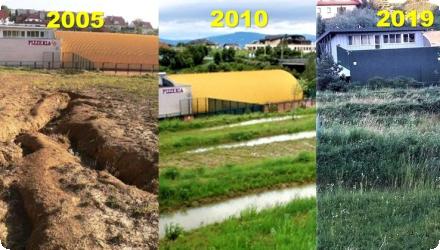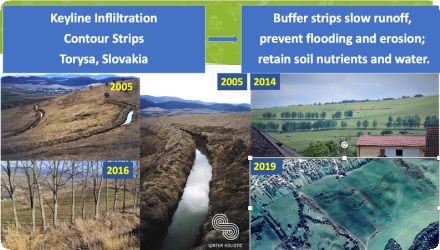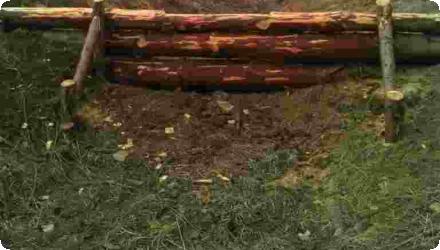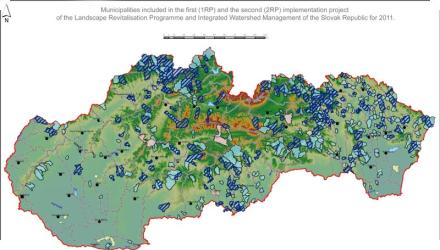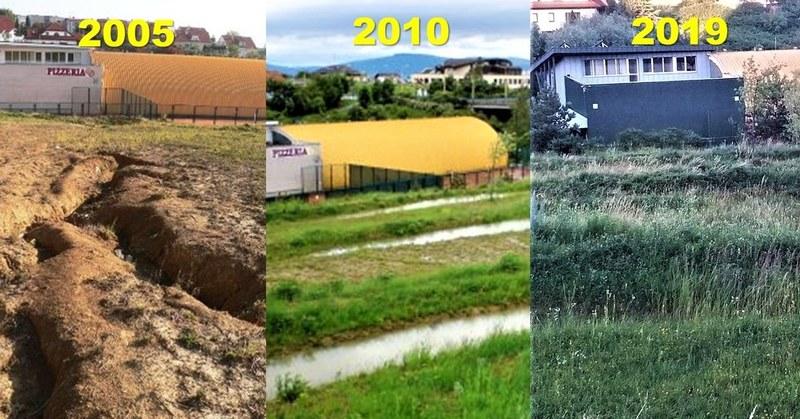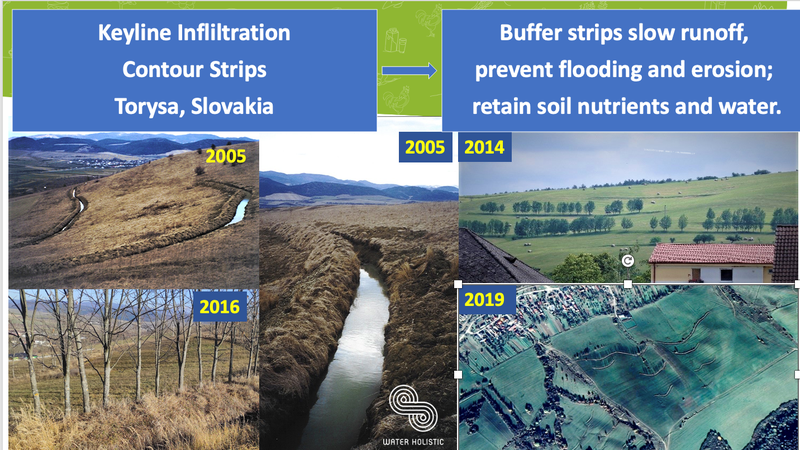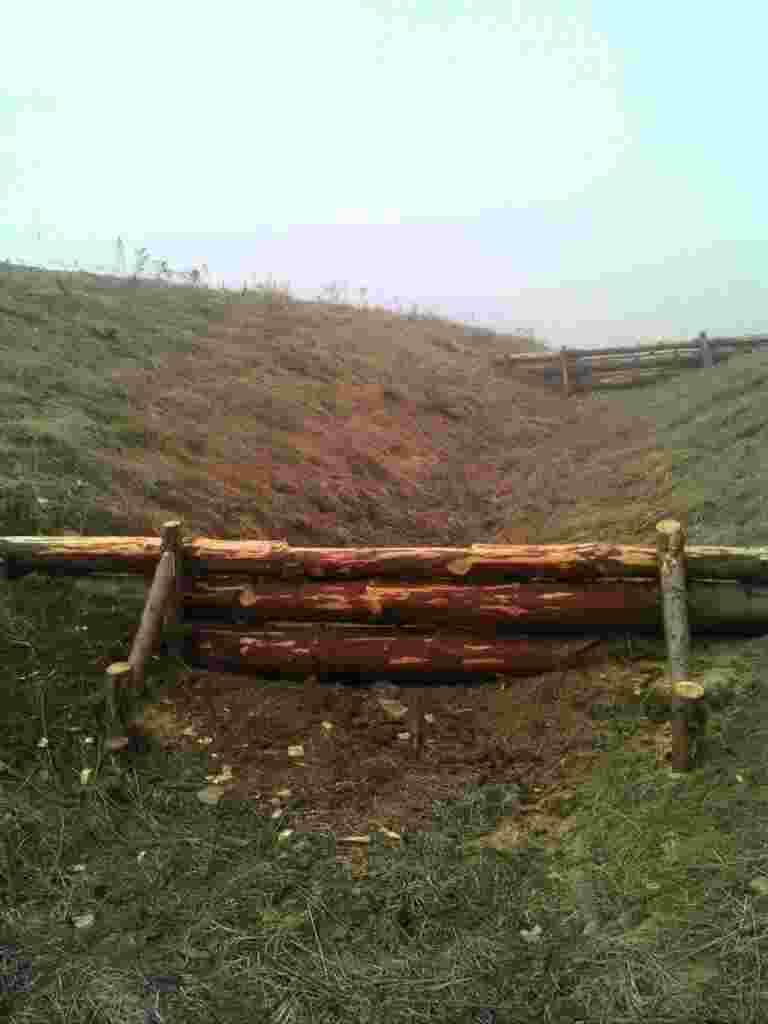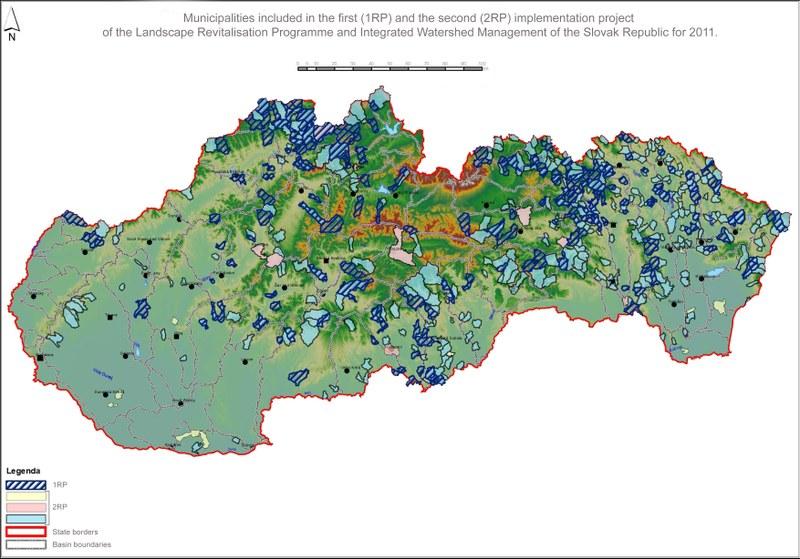Last update
2025
Summary
The national Landscape Revitalisation and Integrated River Basin Management Program (2010) aimed to curb ecosystem degradation and flood/drought risk by retaining rain where it falls, especially in damaged parts of the landscape. It deployed many small water-retention elements across 488 municipalities, restoring landscape storage via basins, ponds and similar measures. Early phases created ~7,700 seasonal jobs with about €43 million invested; the programme was adopted by Government Resolution 744/2010.
Following a change of government in 2012, the national programme was wound down; only ~4% of planned funds were disbursed and monitoring was not established in time. Yet many structures remained in place. In the Košice region alone, ~250,000 m³ of green/retention works were completed in 2010–2012, and the approach continues there under a region-wide Restoration Programme approved in 2021 with a 2021–2030 horizon. The Ministry of Agriculture is also preparing a ‘Climate Fund for Soil’ to support such measures.
Following a change of government in 2012, the national programme was wound down; only ~4% of planned funds were disbursed and monitoring was not established in time. Yet many structures remained in place. In the Košice region alone, ~250,000 m³ of green/retention works were completed in 2010–2012, and the approach continues there under a region-wide Restoration Programme approved in 2021 with a 2021–2030 horizon. The Ministry of Agriculture is also preparing a ‘Climate Fund for Soil’ to support such measures.
Position
Latitude
49.16722
Longitude
20.1311
Project
NWRM
National Id
Slovakia_02
Installation date
2012-03
Implementation Status
Contact
Jovanka Ignjatovic
RBD code
SK40000
Transboundary
0
Photo gallery
Location of the project
Multi-site, nationwide across Slovakia. 488 villages and towns from all regions. Early roll-out started in 24 municipalities in the basins of the Ondava, Torysa, Hornád, Váh and Kysuca rivers.
Project's objectives
Retain 250 million m³ of rainwater in the landscape by building distributed water-retention systems (“cyclic retention capacity”), to mitigate floods and droughts and support ecosystem recovery.
Activate 23 pilot municipalities first, then scale up nationwide.
Engage ~95% of Slovakia’s territory in flood-prevention actions through landscape revitalisation and better land-use practices.
Create jobs: ~300 initially; ≥5,000 jobs by 2011 (conditional on ~€33.5 m allocation).
Improve governance and maintenance of small streams/melioration, and establish a system for upkeep of new retention structures, as part of integrated river-basin management.
Activate 23 pilot municipalities first, then scale up nationwide.
Engage ~95% of Slovakia’s territory in flood-prevention actions through landscape revitalisation and better land-use practices.
Create jobs: ~300 initially; ≥5,000 jobs by 2011 (conditional on ~€33.5 m allocation).
Improve governance and maintenance of small streams/melioration, and establish a system for upkeep of new retention structures, as part of integrated river-basin management.
Involved Partners
| Authority type | Authority name | Role | Comments |
|---|---|---|---|
Climate zone
cool temperate moist
Temperature
10
Precipitation
649
Runoff coefficient
0,85
Elevation range
up to 2500 m
Vegetation class
There is no single predominant class because the programme spans forests, agricultural land and settlements (multi-site). The Košice regional follow-up explicitly targets forests, agricultural land and cities; at national scale, forests and agricultural areas are the dominant land covers.
Water bodies: Ecological Status
Depends on the site
Water bodies: Chemical Status
Depends on the site
Project scale
Large
Project scale specification
National, multi-site programme spanning 488 municipalities across all regions of Slovakia; the NWRM entry lists the application scale as “Country.” It was launched under Government Resolution 744/2010, confirming its nationwide scope.
Performance timescale
1 - 4 years
Project area
1700
Area subject to Land use change or Management/Practice change (ha)
1700
Lifespan
50
Use of soft hydraulics.
Torrential rains in spring and summer.
Design capacity description
Measures and system in cadastre of a settlement of a medium size (1700ha)
Total cost
€43,080,000
Costs total information
Government budget allocations & disbursements (2011): €26.31 m, of which €17.55 m to the 1st implementation project (190 municipalities), €8.04 m to the 2nd (354 municipalities), €0.495 m transferred to the Ministry of Agriculture, plus minor programme/admin items. For 2012, €10 m was allocated (incl. €9.6 m intended for a 3rd project and small amounts for control/monitoring capacity).
Financing authorities
Type of funding
EU-funds: Cohesion and regional development funds
Comments
€18 m European Social Fund
Type of funding
National funds
Comments
€24 m state budget
Compensations
0
Policy context
Due to the farming methods in the territory, the landscape's ability to hold water was substantially weakened, contributing to increase risks of landscape overheating, local and regional climate changes, floods and droughts, soil water erosion, pond silting, permanents soil degradation, disruption of ecosystems, etc.
Land ownership
Mixed ownership. Works could be built on municipal land or on land of another owner/manager, provided the municipality secured the owner’s consent.
Community involvment
Yes
Design consultation activity
| Activity stage | Name | Key issues | Comments |
|---|---|---|---|
|
Design phase
|
Workshops
|
Hundred of workshop with mayors in different regions of Slovakia and meetings with representatives of local public administration authorities.
|
Policy target
| Target purpose |
|---|
|
Increase Water Storage
|
|
Runoff control
|
|
Erosion Control
|
Policy pressure
| Pressure directive | Relevant pressure |
|---|
Policy impact
| Impact directive | Relevant impact |
|---|
Requirement directive
| Requirement directive | Specification |
|---|
Contractual arrangements
0
| Arrangement type | Responsibility | Role | Name | Comments |
|---|
Part of wider plan
1
Wider plan type
| Wider plan type | Wider plan focus | Name | Comments |
|---|---|---|---|
|
National
|
Water
|
Integrated River Basin Management
|
Adopted by the Slovak Republic Government on 27 August 2010
|
|
National
|
Other
|
Act of Employment Services
|
In cooperation with the Central Office of Labor, Social Affairs and Family to help with the high unemployment rate that especially consists of young people and the long-term unemployed.
|
No formal hydrological monitoring was established for the national programme; Košice plans monitoring through 2030 but reports a current funding gap for gauges and related measurements.
The national programme lists no measured parameters because monitoring never started; subsequent administrative inspections verified the existence/functionality of structures rather than hydrological or water-quality metrics. For Košice, the case study specifies the need for gauging stations to evaluate catchment restoration but doesn’t enumerate parameters (e.g., flow, levels) beyond this intent. In short: parameters not specified in sources; evidence refers to inspections/oversight and planned—but unfunded—instrumented monitoring.
Maintenance
In 2011, municipalities signed grant contracts committing to control, maintain and service the built retention/flood-protection works for 20 years. Routine post-storm checks and cleaning of ditches/culverts to keep works functional.
Catchment outlet
N/A info
7700 seasonal jobs during the three first implementation projects
500000
The measures helped to reduce damage and costs that may have been incurred by preventive and rescue investment work during torrential rains in spring and summer.Positive influence on 500 to 1000 municipalities located lower in the river basins because the reduction of flooding risks and drought risks down the watercourse. Enhance the life in the place of water retention.
Information on retained water
In Košice region, the national programme completed 250,000 m³ of GI/rainwater-harvesting works (2010–2012). NGO estimates suggest ~12 million m³ of retained rainwater benefitted municipalities there since 2010. Local example: Jarovnice municipality planned 30,000 m³ but reports ~42,000 m³ of measures built (cost ≈ €3/m³).
Information on increased water storage
The measures helped the villages to diminish flooding risks of torrential rains in 2011 and the retained water was gradually released over the period of extreme drought the affected Slovakia in the second half of the same year.
Information on runoff reduction
The power of rainwater runoff helps to keep the country to be vital
Information on Increased infiltration
There is a better infiltration due to increase of time in water storage
Ecosystem erosion control
1
Water quality overall improvements
Positive impact-WQ improvement
1
The measure protect nature and strengthen biodiversity
Ecosystem impact climate regulation
No information available
Information on Ecosystem impact climate regulation
No measured cooling reported for 2010–2012. The Košice programme expects average −0.7 °C (region) and −1.3 °C (cities) after full implementation; Sušnik et al. 2022 (regional modelling across DE-CZ-SK) also finds WRMs can increase water availability and cool landscapes, but these are modelled potentials, not site monitoring.
Ecosystem provisioning services
1
Information on Ecosystem provisioning services
In the vast majority of cases, local naturally occurring materials such as soil, wood and stone were used for implementing measures.
Key lessons
The case shows that rapid, cost-effective landscape restoration is feasible and that “a big amount of small measures” can add up to meaningful change at catchment scale - an approach presented as a fundamental response to climate change, ecosystem degradation, floods and droughts, with international recognition.
Yet programme continuity matters as much as design. The national roll-out ended early after a change in government; only about 4% of the allocated funds were ultimately used and monitoring was halted before it began. Future nationwide schemes need governance and budget safeguards that outlast political cycles.
Build monitoring in from day one. The Košice regional follow-up (2021–2030) explicitly includes research and monitoring but notes current funding gaps for gauging stations - evidence that instrumentation and data management must be budgeted and scheduled alongside works, not after.
Local stewardship is crucial. Municipalities were implementers and, per grant contracts, must keep the small retention works functional for 20 years after completion; routine post-storm checks and cleaning are part of staying power. This underscores the value of simple designs that communities can maintain.
Quality control and permitting need special attention when deploying tens of thousands of micro-structures. Public debate and inspections in 2013–2014 highlighted concerns and led to financing being stopped at national level; clear technical standards and oversight are essential to maintain safety and credibility.
Finally, scale itself is a management challenge. The NWRM record notes that the “huge amount of small measures for such a big project” was a barrier - future programmes should plan for the administrative load (landowner consents, supervision, documentation) as part of the core design.
Yet programme continuity matters as much as design. The national roll-out ended early after a change in government; only about 4% of the allocated funds were ultimately used and monitoring was halted before it began. Future nationwide schemes need governance and budget safeguards that outlast political cycles.
Build monitoring in from day one. The Košice regional follow-up (2021–2030) explicitly includes research and monitoring but notes current funding gaps for gauging stations - evidence that instrumentation and data management must be budgeted and scheduled alongside works, not after.
Local stewardship is crucial. Municipalities were implementers and, per grant contracts, must keep the small retention works functional for 20 years after completion; routine post-storm checks and cleaning are part of staying power. This underscores the value of simple designs that communities can maintain.
Quality control and permitting need special attention when deploying tens of thousands of micro-structures. Public debate and inspections in 2013–2014 highlighted concerns and led to financing being stopped at national level; clear technical standards and oversight are essential to maintain safety and credibility.
Finally, scale itself is a management challenge. The NWRM record notes that the “huge amount of small measures for such a big project” was a barrier - future programmes should plan for the administrative load (landowner consents, supervision, documentation) as part of the core design.
Success factor(s)
| Success factor type | Success factor role | Comments | Order |
|---|---|---|---|
|
Communication activities
|
secondary factor
|
<p>Hundred of workshop with mayors in different regions of Slovakia and meetings with representatives of local public administration authorities.</p>
|
1
|
|
Attitude of decision makers
|
secondary factor
|
2
|
|
|
Existing staff and consultant knowledge
|
secondary factor
|
<p>The experience gained in the first implementation project help to make better the next ones with a big difference.</p>
|
3
|
Driver
| Driver type | Driver role | Comments | Order |
|---|---|---|---|
|
Organisation committed to it
|
main driver
|
NGO People and Water
|
1
|
|
Other
|
secondary driver
|
Competition between the stakeholders who will invent something original that is better, more effective and of a higher added value.
|
2
|
Transferability
Highly transferable to regions with rural/forest–agricultural mosaics and small catchments, where many small measures can add up. Success hinges on stable governance, landowner consent and permits, clear technical standards, and budgeting O&M plus monitoring (gauges) from day one; also plan for the admin load of thousands of micro-works and address safety/legality concerns around check-dams.
Source(s)
English
